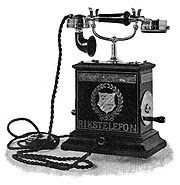In the dark ages before cell phones, people who really needed mobile-communications ability installed radio telephones in their cars. In the radio-telephone system, there was one central antenna tower per city, and perhaps 25 channels available on that tower. This central antenna meant that the phone in your car needed a powerful transmitter -- big enough to transmit 40 or 50 miles (about 70 km). It also meant that not many people could use radio telephones -- there just were not enough channels.
The genius of the cellular system is the division of a city into small cells. This allows extensive frequency reuse across a city, so that millions of people can use cell phones simultaneously.
A good way to understand the sophistication of a cell phone is to compare it to a CB radio or a walkie-talkie.
Full-duplex vs. half-duplex - Both walkie-talkies and CB radios are half-duplex devices. That is, two people communicating on a CB radio use the same frequency, so only one person can talk at a time. A cell phone is a full-duplex device. That means that you use one frequency for talking and a second, separate frequency for listening. Both people on the call can talk at once.
Channels - A walkie-talkie typically has one channel, and a CB radio has 40 channels. A typical cell phone can communicate on 1,664 channels or more!
Range - A walkie-talkie can transmit about 1 mile (1.6 km) using a 0.25-watt transmitter. A CB radio, because it has much higher power, can transmit about 5 miles (8 km) using a 5-watt transmitter. Cell phones operate within cells, and they can switch cells as they move around. Cells give cell phones incredible range. Someone using a cell phone can drive hundreds of miles and maintain a conversation the entire time because of the cellular approach.
In half-duplex radio, both transmitters use the same frequency. Only one party can talk at a time.
In full-duplex radio, the two transmitters use different frequencies, so both parties can talk at the same time.Cell phones are full-duplex.
Subscribe to:
Post Comments (Atom)

No comments:
Post a Comment